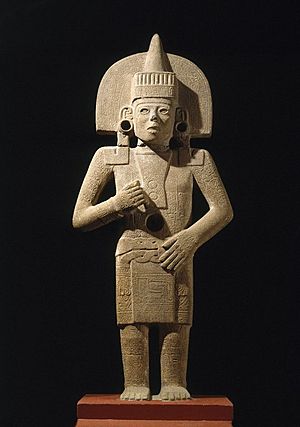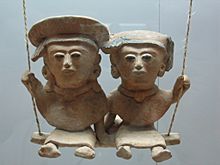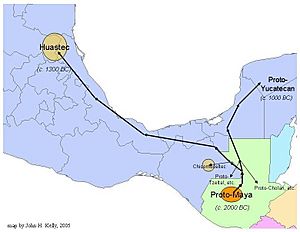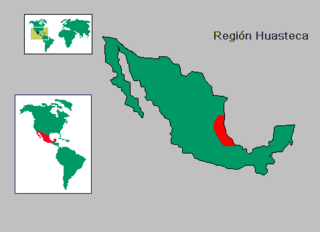Huastec civilization facts for kids

The Huastec civilization was an ancient culture in Mesoamerica. They lived on the Gulf coast of Mexico. Their land included parts of Veracruz, Hidalgo, Querétaro, San Luis Potosí, and Tamaulipas states. The Huastec people were an early group that separated from the Maya peoples and moved north.
We know about the Huastec from their old cities and amazing stone sculptures. By the Late Postclassic period (around 1200 to 1521 AD), they were skilled at working with metals. They even made copper alloys. The powerful Aztec Empire took over the Huastec region in the 15th century. The Aztecs likely made the Huastecs pay them tribute.
Contents
What Was Huastec Culture Like?
The Huastec civilization is not as well-known as some other ancient cultures. However, we have found many stone sculptures and a well-preserved temple. This temple is located at Castillo de Teayo. During the Late Postclassic period, the Huastec region was famous for its metalwork. They created items from copper alloys.
The Aztecs conquered the Huastec region, probably in the 1400s. It is believed that the Huastecs then had to pay tribute to the Aztec Empire. The Huastecs were not united under one ruler. Instead, they lived in many different city-states that often competed with each other.
Some important Huastec archaeological sites include Vista Hermosa and Platanito. Vista Hermosa has 120 platform mounds, and Platanito has 150. Tamtok is another large site from the Late Postclassic period.
Where Did the Huastec People Come From?
The Huastec people are a unique branch of the Maya family. Even though the Huastec language is a Mayan language, the Huastec culture is seen as separate from the main Maya civilization. This is because they did not use the Maya writing system. We also haven't found any Huastec documents from before the Spanish arrived.
Most experts think the Huastecs separated from the main Maya group around 2000 BC. This happened during the Preclassic period. This early split helps explain why their cultures are different. Some studies suggest a more recent separation, possibly after the Classic Maya collapse (around 830–950 AD). If this is true, the Huastecs might have moved from the central Maya area because of this collapse.
What Was Huastec Religion Like?
The Huastecs greatly respected and worshiped Ehecatl. He was the Mesoamerican god of wind. To honor him, the Huastecs built special circular pyramids. Some of these round pyramids are still a key feature of Huastec ruins today.
When the Huastecs came under the rule of the Aztec Empire, the Aztec religious leaders recognized Ehecatl's importance. They added the wind god to their own group of gods. This shows how important Ehecatl was to the Huastec people.
See also
 In Spanish: Cultura huasteca para niños
In Spanish: Cultura huasteca para niños





